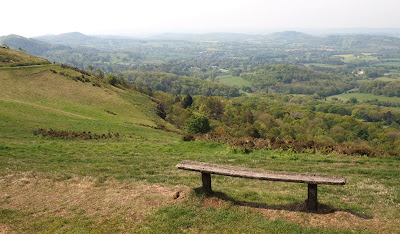A stone monument was erected at the summit of the Worcestershire
Beacon (the highest point in the Malvern Hills) to mark Queen Victoria’s
Diamond Jubilee in 1897. It features a toposcope, which allows visitors to
identify the hills, and other features, that they can observe from this point (see
above). The current toposcope is an exact replacement of the original, which was
stolen (but subsequently recovered), and it was designed by Arthur Troyte
Griffith (1864-1942), a well-known Malvern architect of the time (see below).
Troyte was educated at Harrow (where his father was a
master) and at Oriel College Oxford. Percy M Young [1] describes him as “an all-round
scholar, with special interests in art and literature”, who loved nature and
painted water colours, played chess to a high level, and who was also an enthusiast
for crossword puzzles. After Oxford, his interest in buildings led him to
architecture and he moved to Malvern to set up a practice.
In 1896, Troyte became
friends with Edward Elgar, who was seven years older and who, at that time, was
living in “Forli”, a house in Alexandra Road, Malvern Link. Elgar was well-known locally as a
teacher, musician, and composer of pieces for various instruments and ensembles, but he was a difficult man [2], with a strong need for
recognition and praise; sinking into self-pitying gloom when he felt
things were not going well for him. A contrasting side of Elgar’s personality was
his love of “japes” and the exhilaration provided by being outdoors in the
natural world, and these were both traits that Troyte shared. He was later celebrated
by Elgar in Variation VII of the Enigma Variations, where the composer
highlights his friend’s lack of skill as a musician. Michael Kennedy writes [3]:
The variation is not a portrait.
It merely records “maladroit essays to play the pianoforte; later the strong
rhythm suggests the attempts of the instructor [Elgar] to make something like
order out of the chaos, and the final despairing ‘slam’ records that the effort
proved to be [in] vain.”
As music was so important to Elgar, and he had the facility to
play several instruments well, one can imagine his frustration. It is not
unusual for musicians to have a low tolerance of the performance of those less
gifted than themselves, but the strong bond of affection, and shared interests,
between the two men overcame Elgar’s likely intolerance. Indeed, Troyte remained one
of Elgar’s most valued friends for the rest of his life; many
letters being written between the two [1] that show Troyte’s dependability and
support in all manner of practical matters, including interior design [4]. He
was also a valued guest at dinner parties and other social events, where the
two could enjoy their love of what we now call banter.
If Troyte’s contribution to Queen Victoria’s Diamond Jubilee
was the toposcope on Worcestershire Beacon, Elgar’s was his Imperial March, a
composition that impressed London audiences [3] and which began the progress to
world-wide recognition. In 1897, the two men had been friends for a year and it
was in 1899 that Troyte was celebrated in the Enigma Variations, the piece that
cemented Elgar’s fame and which remains so popular today.
I wrote earlier about my recent walk on the Malvern Hills [5]
and I began my stroll close to Troyte’s old house in Lower Wyche Road on
the flanks of the Worcestershire Beacon. On reaching the top of the Beacon, I had
the reminder of Troyte on the Silver Jubilee monument and, in addition to being
surrounded “by a feeling of Elgar”, it was also good to remember one of Elgar’s
most valued friends. We know that Elgar had generous musical support from Augustus
Jaeger (of Novello and Company - fondly recalled as Nimrod in Variation IX of the
Enigma Variations) and from many others, but Troyte provided a substantial “anchoring
role” in the gifted composer’s life. Those of us who are moved by Elgar’s music probably owe Troyte a good deal.
[1] Percy M Young (ed.) (1956) Letters of Edward Elgar, and other writings. London, Geoffrey Bles.
[2] Michael De-la-Noy
(1983) Elgar: the man. London,
Allen Lane.
[3] Michael Kennedy (1968) Portrait of Elgar. Oxford, Oxford University Press.
[4] Michael Kennedy (2004) The Life of Elgar. Cambridge, Cambridge University Press.
For a recording of Variotion VII of the Enigma Variations,
see https://www.youtube.com/watch?v=ugeTgWjIt6c
For a biography of Arthur Troyte Griffith, see http://www.troytegriffith.org/

















